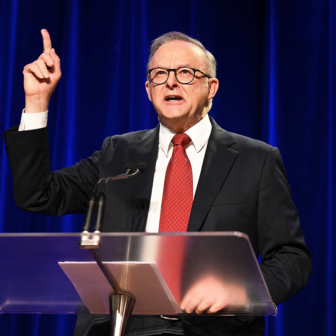Australia’s nuclear debate re-ignited last year when Peter Dutton released the Coalition’s plan to use nuclear power rather than renewables to meet Australia’s emissions-reduction obligations. He gave the distinct impression that this year’s election would be fought on nuclear grounds. “Nuclear makes sense,” the Coalition maintained. “Australia needs nuclear.”
But in recent months Dutton has remained tight-lipped about the detail of his nuclear plans, though he has promised to lift Australia’s nuclear power moratorium and pursue a federal civil nuclear energy program if his party wins government. Under a Coalition government, he promised, Australians would be using nuclear power by some time in the 2050s: “zero-emissions” power that won’t faulter when the sun isn’t shining and the wind isn’t blowing. Nuclear power would kill two birds with one stone, giving energy-hungry and cash-strapped Australians a new, “clean” and as-yet-untapped source of power.
Yet Dutton only mentioned nuclear twice in his budget reply last month, and although he referred to it as both a “visionary” and a “necessary” goal he gave no concrete details about what Australia’s nuclear future might look like (let alone cost). Is the Coalition equivocating on nuclear? And, if so, why?
The debate Peter Dutton initiated — or rather reignited — last year is by no means new. The use of nuclear energy for civilian power in Australia has been floated as a possibility on and off since the 1950s. Nuclear has been heralded as scientifically path-breaking, fiscally responsible, environmentally friendly, and essential for Australia’s future energy needs. Time and again, Australians have been embroiled in feverish stoushes over what now seems an age-old question: to go nuclear, or to not go nuclear?
In the early fifties, when these debates began, Australian nuclear optimism was backlit by the atomic ambitions of Britain and the United States. But Australian politicians also considered that nuclear power would enable a fledgling dominion to prove its worth as a Commonwealth nation and an emergent middle power in the Pacific. Scientists were keen too, urging the government and its constituents to recognise the importance of nuclear to Australia’s future energy needs.
Physicist Harry Messel advocated vocally for a home-grown nuclear capability, arguing that a distinctly Australian scientific training program was necessary to develop nuclear physics in Australia. Echoing Messel’s confidence in nuclear but also evoking a strong retrospective sense of déjà vu, chemical engineer Philip Baxter and physicist Mark Oliphant publicised their shared belief that nuclear power would reduce Australia’s reliance on coal. Nuclear power was seemingly the answer to diversifying Australia’s energy future.
But Baxter and Oliphant readily acknowledged the diseconomies of this energy source. Given the technological hurdles yet to be overcome, Oliphant argued that a viable capacity was at least a decade away. Baxter maintained that only once the economics of nuclear power had sorted themselves out could this new energy source transform Australia.
Rather than commit exorbitant sums to the promise of a long-term, safe and efficient new energy source, the Australian government chose to sit back and follow others’ lead. If Britain and the United States could perfect their own civilian energy programs then Australia would trail in their footsteps more cheaply and efficiently.
In the late 1960s, seemingly fulfilling Oliphant’s prediction that nuclear energy was still a decade off (and also foreshadowing Peter Dutton’s contemporary ambitions), Liberal prime minister John Gorton decided it was time to pursue a nuclear energy capability. “We would not want to be dependent on any country outside our own… for the supply of fuel for a power plant,” he declared. Luckily, Australia had an ample supply of natural uranium. Nuclear power once again appeared inevitable.
In pursuit of an atomic Australia, Gorton’s government approved and sought tenders for a reactor to be sited at Jervis Bay on the NSW coast, the first in a vast network that would power New South Wales and beyond. National development minister David Fairbairn pledged that “by the year 2000 about one-quarter of Australia’s electricity supply would come from nuclear power stations.”
As so often happens, a change of leader and a confluence of factors torpedoed the Jervis Bay project. When Billy McMahon replaced Gorton as prime minister in 1971 amid considerable economic strains, Treasury determined that nuclear energy was no longer economically viable. “The prospects for economic nuclear power in Australia seem rather remote,” the Canberra Times reported in 1972. The numbers just didn’t add up. The possibility of an Australian civil nuclear energy program was shelved indefinitely.
Economics aside, it was increasingly apparent by the 1970s that the world’s hunger for energy necessitated an alternative to fossil fuels. Just as climate change currently looms large in the nuclear debate, that decade’s energy crisis influenced an earlier wave of nuclear optimism in Australia and across the world.
The Club of Rome’s Limits to Growth report, released in 1972, rather alarmingly concluded that “the earth’s interlocking resources… cannot support present rates of economic and population growth.” Neo-Malthusian ideas proliferated as many grew fearful that the world would run out of the resources necessary to feed, house, clothe and provide energy to the world’s rapidly increasing population.
In the following year the decision of the OPEC oil-exporting countries to restrict the supply of Middle Eastern oil sent an economic tsunami across the Western world. The US government, and hence the Australian government, began evaluating its reliance on imported fuels, looking instead for alternative, home-grown sources.
It was from within this heady mix of population expansion and oil shortage that nuclear power (re)emerged as a potential solution to what appeared to be a critically endangered fossil fuel supply.
Closer to home, and seemingly in answer to these worsening crises, several large uranium deposits were identified by mine geologists in the Northern Territory. In 1977, after years of debate and reams of research into the viability and potential environmental impacts of re-establishing uranium exports, prime minister Malcolm Fraser gave the go-ahead for mining in Arnhem Land’s Alligator Rivers region. The Ranger uranium mine, according to Fraser, responded to “the need to supply essential sources of energy to an energy-deficient world.”
Public speculation about Australia’s energy future ran rife, with newspapers reporting that this sleeper energy source had “taken a giant stride towards the hearths and heaters of the home.” Among the familiar faces encouraging this resurgence in interest were Baxter and divisive nuclear physicist Ernest Titterton. Stalwart in his belief that nuclear was the future, Titterton implored readers of the Canberra Times to “appreciate the enormous importance of nuclear energy to the world,” especially given the “consumption trends of the world population.”
Tapping into fears over the world’s “limits to growth,” Titterton detailed the rapidity with which fuel reserves were being consumed by an increasingly ravenous global population. This was the true energy crisis, he argued, warning Australians that the exhaustion of fossil fuel reserves they might force them to “return to a cave-man style of living”: “no heat or cooling for homes, no TV, radio, washing machines, lawn mowers [and] cars.” “No one wants to do this,” he went on, “and so humanity turns to nuclear energy to solve this looming problem.”
As well as dealing with the world’s energy crisis, nuclear power was advertised as “environmentally clean.” Where solar, wind, geothermal and wave power were all considered unproved, dozens of countries around the world had showed (with only a few notable hiccups along the way) that nuclear energy was both viable and far cleaner than coal-fired power.
In the 1970s, as in the 1950s, nuclear advocates considered it inevitable that Australia would come to rely heavily on nuclear energy. In an assurance that could be lifted from the opposition’s current handbook, nuclear power was described as “cleaner, safer, generally cheaper, and less ecologically damaging than the only practicable alternative.” Solar and wind power were mostly discounted, leaving the conversation to circulate around the benefits of nuclear over coal.
Environmentalists and others endeavoured to debunk the notion that nuclear energy was the only “green,” “safe” alternative to coal. Many attempted to expose nuclear energy for its contribution to what they understood as a growing and insatiable greed for more: more industry, more consumer goods, and therefore more irreplaceable energy sources. The conversation around renewable energy in the 1970s sought to encourage the broader Australian population to recognise the fundamental limits of growth in an effort to avoid serous climactic disruption.
Again foreshadowing today’s discussion, nuclear power was part of what could be broadly conceived as an attempt to come up with an alternative energy future. Could nuclear power have been the heir to carbon-emitting fossil fuels in Australia? It certainly could have — at least according to Baxter, who believed all that stood between Australians and nuclear power in the late seventies was “an imaginary waste problem… in the minds of those who presumably just did not want nuclear power.”
Both then and now, this waste problem is far from imaginary, as are many other obstacles. In 2023, the Australian government’s latest attempt to find a place to house Australia’s existing levels of nuclear waste was abandoned following a highly publicised Federal Court battle between the Barngarla Determination Aboriginal Corporation and the federal government.
We are no closer to solving what Baxter described as an imaginary problem. Yet, as the Coalition’s current campaign demonstrates, the notion that nuclear is clean and green remains influential in debates over the nuclear future.
In many countries that use nuclear power, it is considered vital in the transition to renewables. But what about in Australia, where it has failed to gain traction time and time again and an industry like the one envisaged by the Coalition would be starting from scratch?
Last year a CSIRO report concluded that nuclear power “does not currently represent a timely or efficient solution for meeting Australia’s net zero target.” The report’s authors explained that those countries currently relying on this energy source for the green transition have had nuclear power for decades.
While scientists and economists in particular have pointed out several basic flaws in the Coalition’s plan, two in particular echo the hurdles experienced by nuclear energy in the past. They may also assist in understanding the Coalition’s seeming reticence toward spruiking its nuclear plans during Dutton’s budget reply, which instead focused largely on what he called Labor’s “sometimes-on” energy plans versus the Coalition’s own “always-on” gas-fuelled ambitions.
First, the cost of importing the knowledge and infrastructure necessary to get nuclear power off the ground in Australia would negate any cost savings it offers as an energy source. Messel wanted to build Australia’s nuclear research capabilities more than fifty years ago but no Australian nuclear energy program was forthcoming. Going nuclear now would require Australia to import considerable scientific know-how, technology and materials.
Second — and inherently linked to the first — the immense amount of carbon that would be released in the process of building a nuclear power capability in Australia would see the Coalition significantly breach Australia’s emissions commitments.
Nor is joining those “other nineteen top economies in the world in adopting proven, zero emissions nuclear power” as simple (or cost-efficient) as Dutton’s budget response would have constituents believe. Experts maintain that to establish a nuclear power capability rather than committing to renewables and energy storage would cost the Australian taxpayer far more money, materials, energy, and emissions than it would ultimately save them.
Much has changed since the nuclear power discussions of the 1950s, 60s and even 70s. But the similarities between those debates and the one we are having today are stark. For more than seventy years Australians have argued back and forth about the economics and efficiencies of nuclear power. But nuclear power has consistently failed to capture the hearts, minds and wallets of Australians. Understanding the history of nuclear power in Australia thus raises the question: if not then, why now? •




